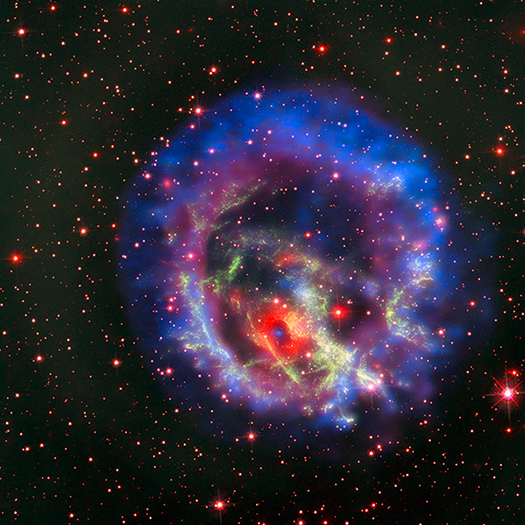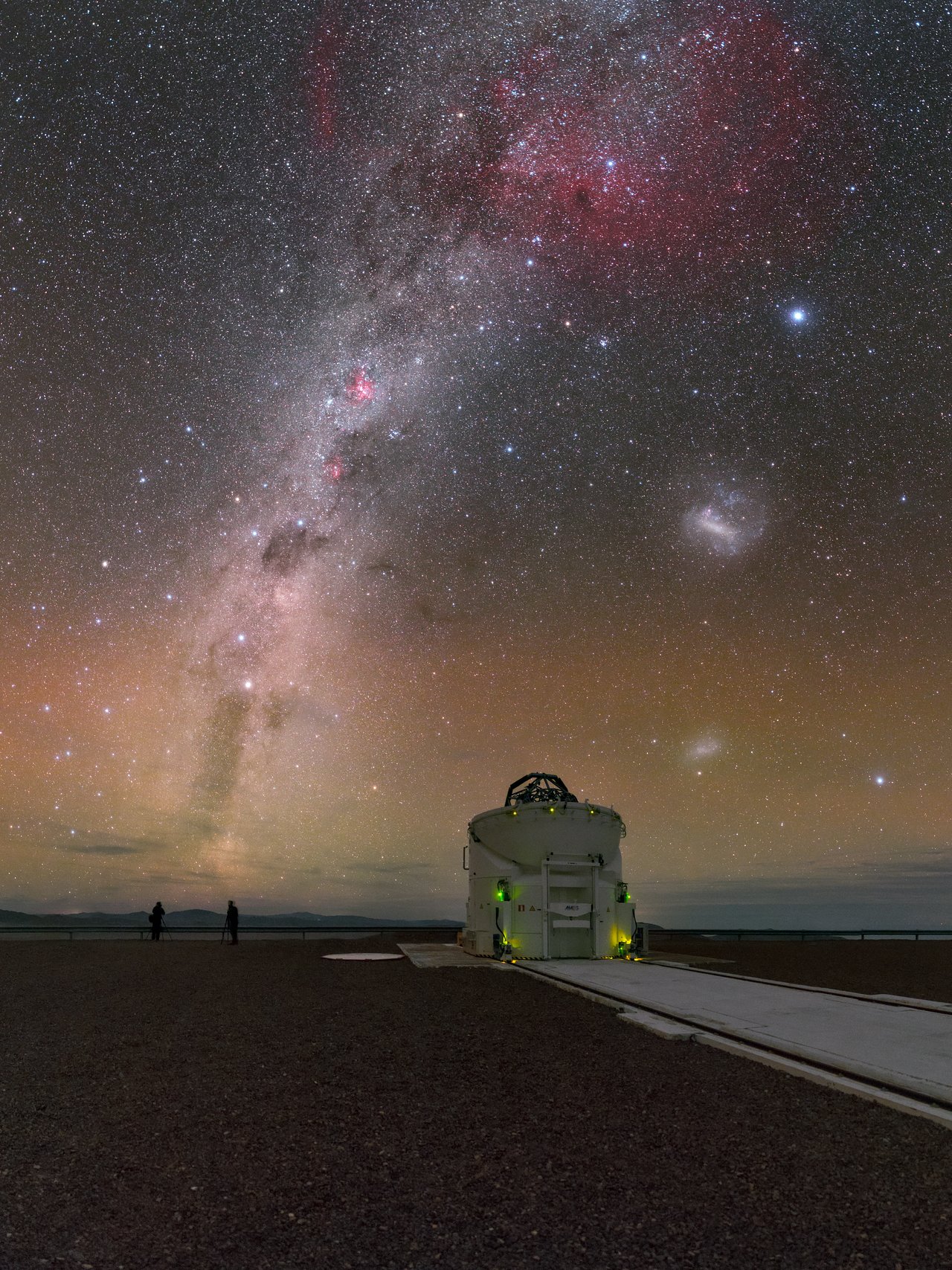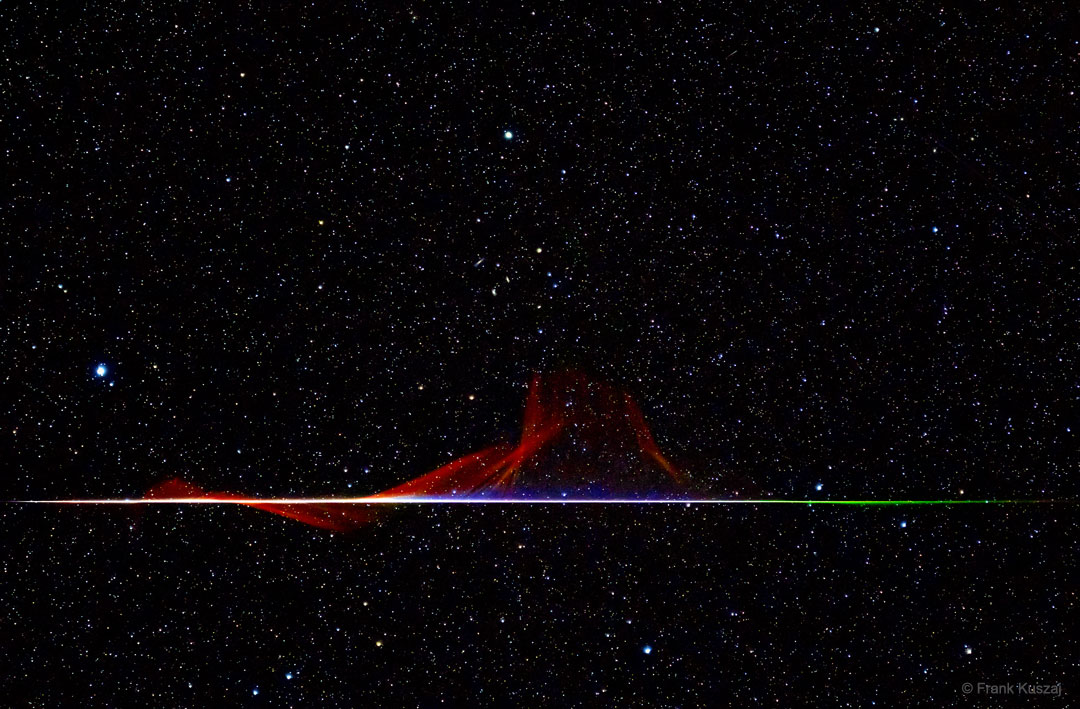Blog
Clyde Austin Stubblefield on drums
more...Astronomers have discovered a special kind of neutron star for the first time outside of the Milky Way galaxy, using data from NASA’s Chandra X-ray Observatory and the European Southern Observatory’s Very Large Telescope (VLT) in Chile.
Neutron stars are the ultra dense cores of massive stars that collapse and undergo a supernova explosion. This newly identified neutron star is a rare variety that has both a low magnetic field and no stellar companion.
The neutron star is located within the remains of a supernova — known as 1E 0102.2-7219 (E0102 for short) — in the Small Magellanic Cloud, located 200,000 light years from Earth.
This new composite image of E0102 allows astronomers to learn new details about this object that was discovered more than three decades ago. In this image, X-raysfrom Chandra are blue and purple, and visible light data from VLT’s Multi Unit Spectroscopic Explorer (MUSE) instrument are bright red. Additional data from the Hubble Space Telescope are dark red and green.
Oxygen-rich supernova remnants like E0102 are important for understanding how massive stars fuse lighter elements into heavier ones before they explode. Seen up to a few thousand years after the original explosion, oxygen-rich remnants contain the debris ejected from the dead star’s interior. This debris (visible as a green filamentary structure in the combined image) is observed today hurtling through space after being expelled at millions of miles per hour.

John Stubblefield (February 4, 1945 – July 4, 2005) was an American jazz saxophonist, flautist, and oboist.
Stubblefield was an adaptable musician, having played with the World Saxophone Quartet (´86-´88), Reggie Workman (´89-´93), McCoy Tyner (´84 Clark), Freddie Hubbard (´85), and George Russell (´85). Stubblefield also served for a time as a jazz ensemble director at Rutgers University, following the departure of Paul Jeffrey in 1983.
more...Born February 4th 1938 and raised in Ashland, MS, guitarist Joe Beard grew up with the Murphy brothers, one of whom later found an international following as Matt “Guitar” Murphy. Beard moved to Rochester, NY, and from time to time would visit one of his brothers in Chicago. He quickly became enamored of the blues being played in clubs there by people like Jimmy Reed and Sonny Boy Williamson. Beard sat in with John Lee Hooker one night and received encouraging words from Hooker.
Beard befriended classic blues guitarist Son House, who was a neighbor in Rochester.. Beard worked as an electrician by day and would occasionally play out at night and on weekends for most of the ’60s on through to the ’80s. At Rochester’s famed BK Lounge, Beard and his backing bands opened for Bobby Bland, Albert King, and others.
Joe has played many major festivals in the US and Europe and was inducted to the Rochester Music Hall Of Fame in 2017. He has released 4 albums to great critical acclaim. One album featured Ronnie Earl and two others featured Duke Robillard.
more...Jutta Hipp (February 4, 1925 – April 7, 2003) was a jazz pianist and composer. Born in Leipzig in the Weimar Republic, she initially listened to jazz in secret, as it was not approved of by the Nazi authorities. After surviving World War II, she became a refugee, often lacking food and other necessities. By the early 1950s, she was a touring pianist and soon led her own bands. Critic Leonard Feather heard Hipp perform in Germany in 1954, recorded her, and organized her move to the United States the following year. Club and festival appearances soon followed, as did album releases.
For reasons that are unclear, Hipp’s last recording was in 1956; she started working in a clothing factory, and ultimately cut herself off from the music world. She remained in the United States, and worked for the clothing company for 35 years. Hipp was born on February 4, 1925 in Leipzig in the Weimar Republic. Her family was middle class, with a Protestant background. She began playing the piano at the age of nine.
more...This beautiful photograph of the southern sky was taken by ESO Photo Ambassador Petr Horálek from ESO’s Paranal Observatory in Chile. Petr was not alone at Paranal. Standing to the bottom left of the image, next to an Auxiliary Telescope of the Very Large Telescope Interferometer (VLTI), are astrophotographers Yuri Beletsky and Babak Tafreshi, both of whom are also Photo Ambassadors for ESO. The duo are seen beneath a sky filled with stunning phenomena.
The bright, dominant band of the Milky Way cuts across the sky, with the Gum Nebula (Gum 12) appearing at the top of the frame in red. The Large Magellanic Cloud, a satellite galaxy of the Milky Way, is an especially bright blotch to the centre right — just below Canopus, the brightest star in both this view and the southern constellation of Carina. A beautiful green and reddish shimmer is also visible at the bottom of the image, seemingly rising up from the horizon. This phenomenon is known as airglow and consists of faint light emitted by the Earth’s atmosphere. Airglow prevents the night sky from being completely dark, and is explained in detail in ESOcast 78.

Bobby Durham (February 3, 1937 – July 6, 2008) was an American jazz drummer.
Durham was born in Philadelphia and learned to play drums while a child. He played with The Orioles at age 16, and was in a military band between 1956 and 1959. After his discharge he played with King James and Stan Hunter. In 1960 he moved to New York City, where he played with Lloyd Price, Wild Bill Davis, Lionel Hampton, Count Basie, Slide Hampton, Grant Green, Sweets Edison, Tommy Flanagan, Jimmy Rowles, and the Duke Ellington Orchestra, in which he played for five months. While working with Basie he met Al Grey, and was a member of several of Grey’s small ensembles. He accompanied Ella Fitzgerald for more than a decade, and worked with Oscar Peterson in a trio setting.
Durham also played in trios with organists such as Charles Earland and Shirley Scott, and there was a resurgence in interest in Durham’s work during the acid jazz upswing in the 1990s. Many of Durham’s projects, both as sideman and as leader, have come due to his association with producer Norman Granz, who had him work with Ella Fitzgerald, Count Basie, Harry Edison, Flanagan, and Joe Pass. Durham has led his own combos as well; he is noted for scat singing along with his drum solos. Durham has also performed often with pop and soul musicians such as Frank Sinatra, James Brown, Ray Charles, and Marvin Gaye.
He died of lung cancer in Genoa, Italy, aged 71.
more...John Watson Jr. (February 3, 1935 – May 17, 1996), known professionally as Johnny “Guitar” Watson, was an American blues, soul, and funkmusician and singer-songwriter. A flamboyant showman and electric guitarist in the style of T-Bone Walker, Watson recorded throughout the 1950s and 1960s with some success. His creative reinvention in the 1970s with funk overtones, saw Watson have hits with “Ain’t That a Bitch” and “Superman Lover”. His successful recording career spanned forty years, with his highest chart appearance being the 1977 song “A Real Mother for Ya”. Watson was born in Houston, Texas. His father John Sr. was a pianist, and taught his son the instrument. But young Watson was immediately attracted to the sound of the guitar, in particular the electric guitar as played by T-Bone Walker and Clarence “Gatemouth” Brown.
more...Lillian Hardin Armstrong (née Hardin; February 3, 1898 – August 27, 1971) was a jazz pianist, composer, arranger, singer, and bandleader. She was the second wife of Louis Armstrong, with whom she collaborated on many recordings in the 1920s.
Her compositions include “Struttin’ with Some Barbecue“, “Don’t Jive Me”, “Two Deuces”, “Knee Drops”, “Doin’ the Suzie-Q”, “Just for a Thrill” (which was a hit when revived by Ray Charles in 1959), “Clip Joint”, and “Bad Boy” (a hit for Ringo Starr in 1978). Armstrong was inducted into the Memphis Music Hall of Fame in 2014. She was born Lillian Hardin in Memphis, Tennessee, where she grew up in a household with her grandmother, Priscilla Martin, a former slave from near Oxford, Mississippi.
more...I had the pleasure of working with Flory years ago with Voices of Sepharad. She was a wonderful inspiration and dedicated songwriter and singer. Have a great new adventure Flory.
Jagoda Flory Jagoda Beloved “Nona” Flory Jagoda, 97, died peacefully on January 29, 2021 at Silverado Alexandria Memory Care Community. Peaceful and strong-spirited, that’s how Flory Jagoda’s daughters Betty and Lori would like her to be remembered. Flory Jagoda is a Bosnian-Jewish born guitarist, composer and singer-songwriter. She comes from a centuries-old tradition with roots in the Iberian Peninsula, and is the last remaining member of the Altaras family lineage. Her family was one of many Sephardic Jewish families forced to flee Spain and Portugal in the 14th and 15th centuries, eventually settling in Sarajevo. Jagoda’s life story is also marked by resettlement and fleeing. Escaping Nazi persecution, she finally put down her roots in the United States after World War II. Jagoda is known for her interpretation of Ladino (Judeo-Spanish) songs and sevdalinka (Bosnian folk ballads). In 2002, Flory Jagoda received a National Heritage Fellowship from the National Endowment for the Arts, the highest honor given to artists in the United States. Now 95 and suffering from advanced dementia, Jagoda relies on her children to tell her story. Her daughters, Lori and Betty, sat down with Oslobodjenje to speak about their mother’s contributions to the arts and Sephardic music, and her deep love for Bosnia and Herzegovina.
more...Meteors can be colorful. While the human eye usually cannot discern many colors, cameras often can. Pictured is a Quadrantids meteor captured by camera over Missouri, USA, early this month that was not only impressively bright, but colorful. The radiant grit, likely cast off by asteroid 2003 EH1, blazed a path across Earth’s atmosphere. Colors in meteors usually originate from ionized elements released as the meteordisintegrates, with blue-green typically originating from magnesium, calcium radiating violet, and nickel glowing green. Red, however, typically originates from energized nitrogen and oxygen in the Earth’s atmosphere. This bright meteoric fireball was gone in a flash — less than a second — but it left a wind-blown ionization trail that remained visible for several minutes.

Alphonso Johnson (born 2 February 1951) is an American jazz bassist active since the early 1970s. Johnson was a member of the influential jazz fusion group Weather Report from 1973 to 1975, and has performed and recorded with numerous high-profile rock and jazz acts including Santana, Phil Collins, members of the Grateful Dead, and Chet Baker.
Born in Philadelphia, Pennsylvania, Johnson started off as an upright bass player, but switched to the electric bass in his late teens. Beginning his career in the early 1970s, Johnson showed innovation and fluidity on the electric bass. He sessioned with a few jazz musicians before landing a job with Weather Report, taking over for co-founding member Miroslav Vitous. Johnson debuted with Weather Report on the album Mysterious Traveller. He appeared on two more Weather Report albums: Tale Spinnin’ (1975) and Black Market (1976) before he left the band to work with drummer Billy Cobham. During 1976-77 he recorded three solo albums as a band leader, for the Epic label, in a fusion-funk vein.
more...More Posts
- Daily Roots with Prince Buster
- The Cosmos with R Aquarii
- Tomasz Stanko Day
- Clyde Bernhardt Day
- World Music with Diali Cissokho & Kaira Ba
- Daily Roots with Linval Thompson
- The Cosmos with NGC 3576
- Bela Fleck Day
- Lee Morgan Day
- Blind Boy Fuller Day
- World Music with Omar Bashir
- Daily Roots with Owen Gray
- The Cosmos with NGC 6300
- Mitch Mitchell Day
- Colin Bailey Day
- World Music with Combo Ginebra
- Daily Roots with Freddie McGregor
- The Cosmos with IRAS 23166+1655
- Jaimoe Day
- Louis Jordan Day
